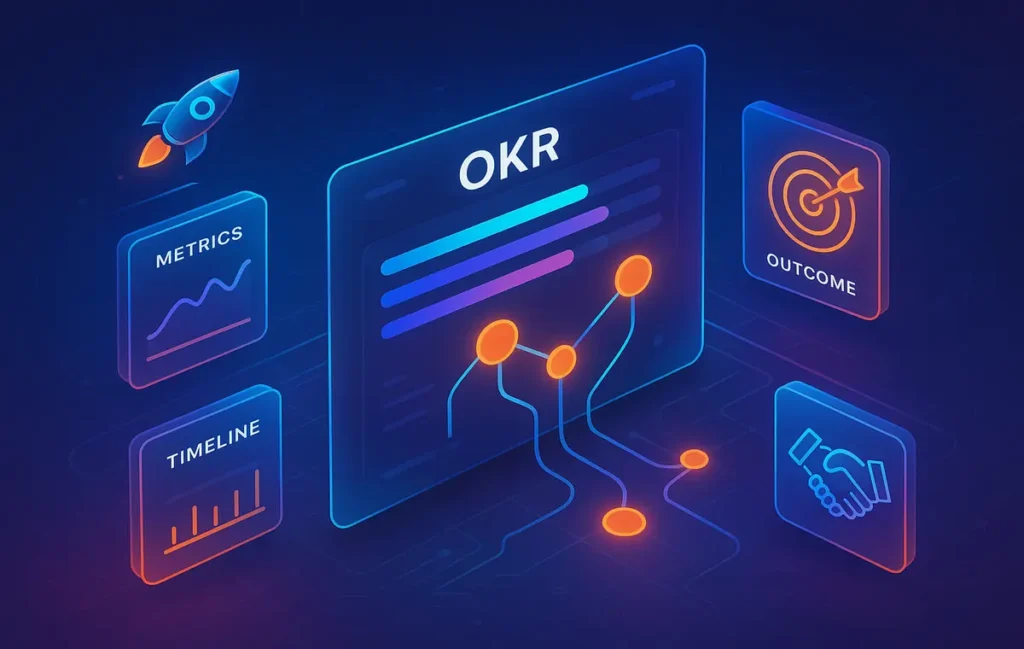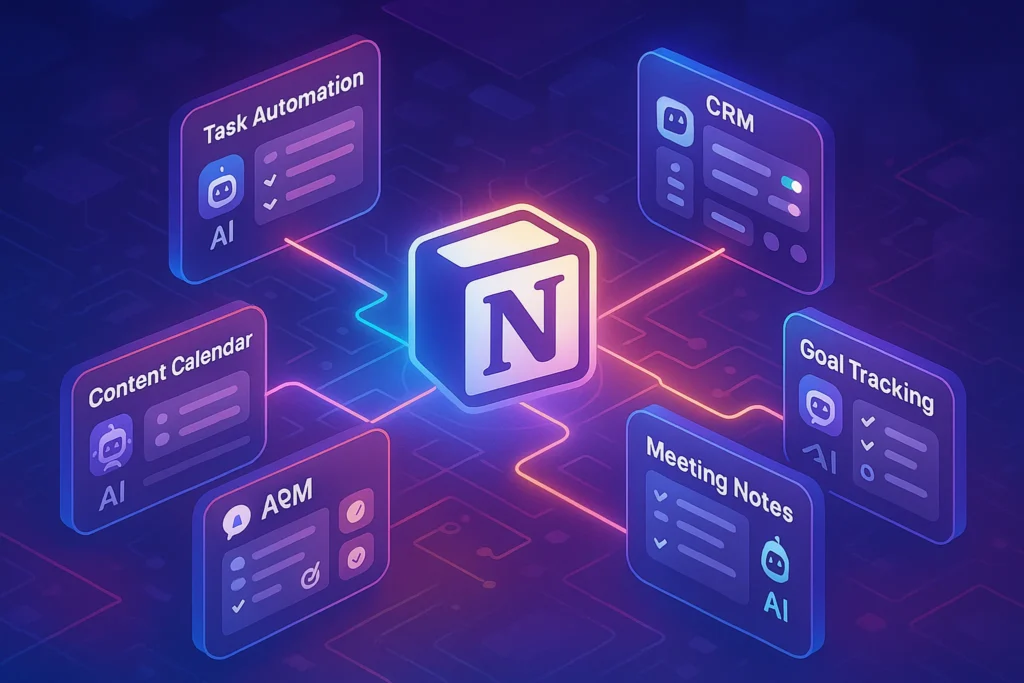🔥 Introduction: Why Startups Need a Goal-Setting Framework
Startups are fueled by ambition. Founders dream big, investors demand outcomes, and teams move fast. Yet ambition without structure quickly dissolves into chaos. Too often, startups drown in competing priorities, fragmented tools, and endless meetings that lead to little alignment. Everyone works hard, but progress feels scattered.
This is where OKRs—Objectives and Key Results—step in. Originating from Silicon Valley’s most successful companies, OKRs give teams a way to define outcomes, not just tasks. But writing OKRs on paper or tracking them in spreadsheets often fails. Updates get lost, goals are forgotten, and alignment across teams disappears. That’s why startups increasingly turn to dedicated OKR software.
💡 Nerd Tip: Startups don’t fail because they lack ideas. They fail because they lack focus. A good OKR framework channels that focus where it matters.
📝 Why Use OKR Software Instead of Spreadsheets?
Many founders begin OKR tracking in Google Sheets or simple docs. At first, it feels efficient: cheap, flexible, and familiar. But as soon as the team grows beyond five people, the cracks start showing. Manual updates mean OKRs quickly fall out of sync. Errors creep in, creating different versions of the truth. Spreadsheets also lack visualization—progress becomes buried in rows and columns instead of visible dashboards.
OKR software solves these pain points by automating updates, integrating with tools like Slack, Jira, or best smart calendar apps for productivity, and providing clarity through dashboards. Instead of chasing updates across docs, everyone logs into the same platform and sees alignment in real time. Notifications remind teams to check in weekly. Leadership gains a bird’s-eye view of company health without relying on ad hoc reporting.
💡 Nerd Tip: Think of spreadsheets as training wheels for OKRs. At some point, they hold you back more than they help.
⚙️ Core Features Startups Should Look For
Not every OKR tool is built equally. Startups, unlike large enterprises, need simplicity and speed. When evaluating options, several features make the difference between adoption and abandonment.
First, UX must be clean and intuitive. If a tool feels like learning a new operating system, your team won’t use it. Startups thrive on tools that can be adopted in days, not weeks.
Second, alignment features—or “cascading OKRs”—are essential. They connect company-wide objectives to team-level goals and then to individual key results. This ensures engineers, marketers, and sales teams aren’t running in different directions.
Dashboards and progress visuals keep OKRs alive beyond kickoff meetings. Weekly or monthly check-ins prompt teams to review results, learn from progress, and adapt quickly. Notifications and alerts reduce the friction of adoption, reminding team members to log updates.
Integrations are another deciding factor. Tools that connect with Slack, Google Workspace, or best workflow automation tools for solopreneurs & remote teams prevent OKRs from becoming another silo. Scalability and customization also matter, since a tool should grow with your startup rather than needing replacement at Series A.
💡 Nerd Tip: Your OKR software shouldn’t just track goals—it should become part of your team’s daily workflow.
🏆 Top OKR Tools for Startups (2025 Picks)
The OKR software market in 2025 is crowded, but a few tools stand out for startups.
Weekdone has built its reputation on simplicity. With helpful onboarding and pre-set templates, it allows small teams to get started in days. Its biggest strength is teaching OKR habits as you use it. However, it can feel limiting for startups scaling quickly.
SugarOKR offers a free and simple entry point. For early-stage founders experimenting with OKRs, SugarOKR removes the barrier of cost. It lacks deeper integrations, but for teams of under 20, it’s enough to instill the habit of check-ins.
Tability focuses heavily on transparency and engagement. Its lightweight UI and strong check-in reminders ensure OKRs don’t get forgotten. Many startups choose Tability because it balances clarity with accountability without overwhelming users.
More advanced tools like Quantive, Perdoo, and Cascade target teams that need enterprise-grade features. These platforms offer scalability, advanced reporting, and stronger alignment systems—but they may be overkill for a startup of 10.
💡 Nerd Tip: Start small. Pick a tool your team will actually use. Switching later is easier than forcing a complex platform too early.
🚀 How to Implement OKR Software in a Startup
Buying software is easy. Driving adoption is hard. Startups must implement OKRs carefully to avoid resistance.
The first step is choosing a tool that matches team size and culture. For a team of 5–15, SugarOKR or Weekdone works well. For 20+ employees, Tability or Perdoo provide room to scale.
Next, run a pilot phase with one team. Marketing, for example, can adopt OKRs for a quarter, tracking goals like lead generation or campaign reach. Their feedback refines how the rest of the company will roll out the system.
Training is vital. Don’t assume everyone knows how to write strong objectives or measurable key results. Hold workshops where the team practices writing OKRs that are ambitious but realistic.
OKRs should also integrate into routines. Weekly stand-ups or monthly all-hands become natural check-in points. Tools like Slack integrations help remind teams to update progress.
Finally, review and adapt. At the end of each cycle, evaluate not just outcomes but also the process. Did the tool encourage focus? Did it reduce meetings? Did it create alignment? If not, iterate.
💡 Nerd Tip: OKRs succeed when they become habits. Build them into your rituals, not just your software.
📈 Case Study: From Chaos to Clarity
Imagine a startup with 18 employees working across product, marketing, and sales. Before OKRs, every team used different tools and priorities clashed. Marketing focused on brand awareness, sales on quick deals, and product on features investors wanted—not what users needed.
They adopted Tability to unify goals. Within two cycles, the company defined three key objectives: acquire 1,000 paying users, reduce churn by 15%, and launch a new feature set by Q2. Each department aligned their key results directly under these objectives.
Weekly check-ins revealed blockers early. Marketing noticed campaigns weren’t driving sign-ups, so they collaborated with product to optimize the onboarding flow. Sales saw churn patterns and fed insights back to product. Within six months, the startup hit 1,200 paying users and reduced churn by 17%.
The founder later shared: “We stopped arguing about priorities. The tool forced us to look at the same scoreboard.”
📊 Measuring ROI & Success of OKR Software
Startups operate on tight budgets, so measuring the ROI of any tool is critical. OKR software pays for itself when it creates measurable improvements in alignment and outcomes.
Key metrics include the percentage of goals achieved, the consistency of team check-ins, and reductions in wasted meetings. For example, one startup cut coordination meetings by 30% after adopting OKR software, as dashboards replaced long status updates.
Another metric is speed to market. When teams align faster, they launch features sooner. If OKR adoption shortens delivery timelines by even 10%, the impact on revenue can be dramatic.
💡 Nerd Tip: ROI from OKR software isn’t just financial—it’s cultural. If your team feels more focused and motivated, the tool is already paying off.
⚠️ Challenges & Common Pitfalls
Despite the benefits, startups often stumble when adopting OKR tools. One mistake is treating OKRs mechanically—filling in objectives and key results without embedding them into culture. This turns the process into a chore instead of a driver.
Another pitfall is overcomplication. Some founders pick enterprise-grade tools with steep learning curves, overwhelming their teams. Complexity breeds resistance, and employees quietly stop updating OKRs.
Startups also risk abandoning tools mid-way. Excitement fades after the first quarter if leadership doesn’t champion usage. Consistency is key.
Finally, tying OKRs too directly to compensation can backfire. When goals become punishments or bonuses, teams may sandbag targets instead of aiming ambitiously.
💡 Nerd Tip: Keep OKRs ambitious but safe. They should stretch your team, not scare them.
⚡ Try an OKR Tool That Fits Your Startup
Not sure where to start? Explore OKR software like Weekdone, Tability, or SugarOKR to test how structured goals transform your team’s focus.
📌 OKR vs KPI: Clearing the Confusion
One of the most common mistakes startups make is mixing OKRs with KPIs. While both are measurement tools, they serve very different purposes. KPIs (Key Performance Indicators) track ongoing performance, like website traffic, churn rate, or monthly recurring revenue. They tell you how the engine is running.
OKRs (Objectives and Key Results), on the other hand, set ambitious directions and measurable outcomes for growth. They answer a different question: where do we want to go, and how will we know if we’re getting there? For example, a KPI might measure churn at 8%, but an OKR would aim to reduce churn from 8% to 5% in the next quarter by improving onboarding.
💡 Nerd Tip: Use KPIs to monitor the health of your business, and OKRs to change its trajectory. Both work together but are not interchangeable.
🔄 Integration with Automation & Analytics
The true power of OKR software emerges when it integrates with automation and analytics. Imagine your team using how to automate your marketing reports so every week, campaign data flows directly into your OKR dashboard. Instead of manually updating “Generate 1,000 leads this quarter,” the system automatically pulls numbers from Google Analytics or your CRM.
Similarly, startups that already rely on top 10 automation tools for marketers or best workflow automation tools for solopreneurs & remote teams can plug OKR tracking into those flows. This eliminates the risk of stale data and ensures decision-making is always based on the latest results.
💡 Nerd Tip: Automating OKR updates reduces admin work and reinforces the idea that OKRs are living metrics, not forgotten documents.
💰 Cost & ROI for Startups on a Budget
Early-stage startups scrutinize every subscription fee. On the surface, paying $5–$15 per user each month for OKR software may feel like a luxury. But when you factor in the hidden costs of misalignment—extra meetings, duplicated work, or delayed launches—the ROI becomes clear.
Consider a startup spending 20 hours a month on coordination meetings. If OKR dashboards cut those meetings in half, that’s 10 hours saved across the team. Multiply by average hourly rates, and the savings often exceed the software’s cost. Plus, better alignment accelerates growth. Even a 5% improvement in execution speed—shipping features earlier, closing sales faster—translates into revenue gains.
💡 Nerd Tip: Don’t ask, “How much does this tool cost?” Ask, “How much is disorganization costing us today?”
🌱 Cultural Dimension of OKRs
Software alone won’t transform a startup—culture will. OKRs reinforce a culture of transparency, accountability, and collaboration. When every team member can see what others are working toward, silos break down.
OKRs also support a “fail fast, learn fast” culture. Missing a key result isn’t failure; it’s feedback. In fact, ambitious OKRs are often designed with only 70% achievement in mind, because the goal is to stretch the team beyond comfort zones. Startups that embrace this mindset create resilience, where teams see setbacks as opportunities to learn, not punishments.
💡 Nerd Tip: The best OKR software doesn’t just track goals—it nudges culture toward openness and growth.
🤖 Future Outlook: AI-Powered OKRs
Looking ahead, AI is reshaping OKR platforms. Instead of static dashboards, future tools will act like copilots. They’ll analyze past performance, predict which Key Results are at risk, and suggest course corrections automatically. For instance, if sales targets look unlikely to be met, the software might recommend reallocating marketing spend or adjusting outreach tactics.
Some platforms are already experimenting with natural language OKR writing. Founders simply type “Increase user engagement in Q2,” and the system generates measurable Key Results with benchmarks. Combined with predictive analytics, AI-driven OKRs could transform strategic planning into a proactive, adaptive process.
💡 Nerd Tip: Keep an eye on AI-enabled OKR features. They’ll shift your tool from passive tracking to active coaching.
🗣️ Founder Quotes & Anecdotes
Nothing grounds CRO or OKR theory like lived experience. Here are two real-world founder perspectives:
-
A SaaS founder on X wrote: “We ditched spreadsheets and moved to OKR software. First quarter adoption was rough, but by Q2 we cut wasted meetings in half and finally agreed on what ‘success’ meant.”
-
A health-tech startup CEO shared: “Our early OKRs failed because we tied them to bonuses. Once we separated performance reviews from OKRs, the team felt safer aiming high—and we actually achieved more.”
These anecdotes reveal a simple truth: OKRs succeed when they’re cultural, not just technical. The right tool helps, but leadership mindset is the real multiplier.
💡 Nerd Tip: Borrow from founders’ mistakes. Avoid tying OKRs too tightly to pay, and celebrate learning as much as achievement.
📬 Want More Smart Productivity Tips Like This?
Join our free newsletter and get weekly insights on goal-setting tools, automation, and future-of-work strategies. Straight to your inbox—no fluff, just clarity.
🔐 100% privacy. No noise. Just value-packed productivity tips from NerdChips.
🧠 Nerd Verdict
For startups, focus is the ultimate currency. OKR software transforms scattered energy into aligned execution. Spreadsheets may work at the beginning, but they collapse under growth. The right software brings clarity, accountability, and momentum.
At NerdChips, our verdict is clear: simplicity and transparency matter most. A tool that keeps OKRs visible and easy to track will do more for a startup than a bloated enterprise system. When chosen wisely, OKR software doesn’t just track progress—it drives it.
❓ Nerds Ask, We Answer
💬 Would You Bite?
If adopting the right OKR software could double your team’s focus, would you commit time to setting it up—or keep running on scattered spreadsheets?
Crafted by NerdChips for founders and teams who believe focused goals build the future.



